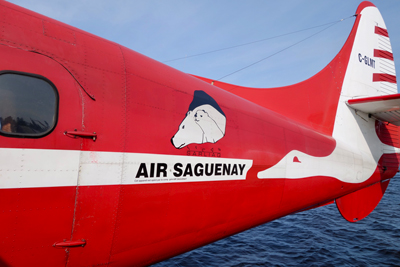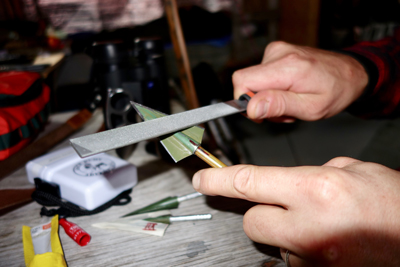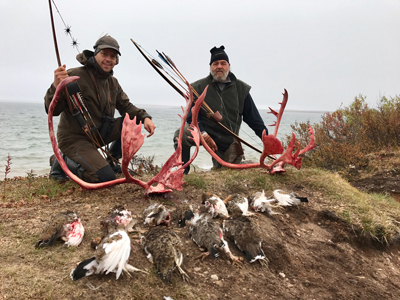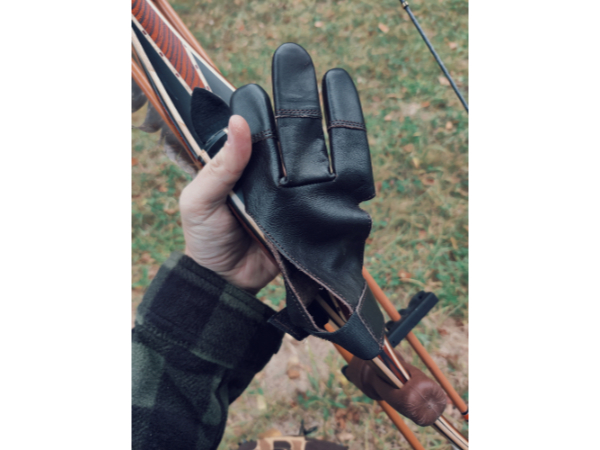It all began about twenty years ago, when I started hunting with a bow and arrow. Growing up in the heart of the Alps, I have always been in close contact with nature. I have developed hunting skills since I was a boy; a gift given to me from my grandfather, who used to be a professional guide and was also involved in wildlife control.
A hunting trip to the far and wild Canada has been my dream since childhood. Therefore, some years ago through my friend Max Turczyn from Ontario, I found an outfitter named Jack Hume Adventures. After making contact with Jack about two years ago, I signed a contract for a hunting trip with the perfect organization.
Finally September 1st, 2017 came and, after months of plans and practice, my hunting friend Claudio Canonica and I flew from Zurich to Montreal. Arriving in Montreal we enjoyed the city and the surrounding area for two days before heading to the Inuit territories.
 On the third day of our trip we finally had the alarm set at 3 o’clock in the morning to go and weigh our gear and backpacks. We loaded the plane to Mirabel Airport, outside Montreal, and we flew to Canipiscau where the JHA basecamps were located. Amanda, Richard Hume’s wife, spoiled us with a fabulous breakfast and helped us to fill in all of the documents and bureaucratic parts of the hunting permits.
On the third day of our trip we finally had the alarm set at 3 o’clock in the morning to go and weigh our gear and backpacks. We loaded the plane to Mirabel Airport, outside Montreal, and we flew to Canipiscau where the JHA basecamps were located. Amanda, Richard Hume’s wife, spoiled us with a fabulous breakfast and helped us to fill in all of the documents and bureaucratic parts of the hunting permits.
Around 9:00 am, we boarded a 1962 Beaver, also called the “workhorse of the north”, to fly to Bobby Lake Camp, located on the 58th north parallel to the right of the Kakiattukallak Lake, not so far from Leaf River, in the heart of Nunavik. Landing by seaplane on the cold waters of Bobby Lake, the red, green and brown colors of the arctic tundra dominated. We were warmly received by our guide Ricky, and his wife Christine who was our camp chef for the next eight days.
We quickly unloaded our luggage and got ready for the first outing. The weather was nice, with a blue sky, but we knew that here in the north there are many unpredictable variables such as rain, wind, snow storms, and predators like polar bears.
With our longbows, and arrows tipped with razor-sharp Zwickey Delta broadheads, we climbed into our canoe and proceeded to the other bank of Bobby Lake to try to spot the caribou of the “Leaf River Herd.”
 Meanwhile the weather had changed for the worse, so under strong winds and scattered rain we scanned the horizon with our binoculars from behind a rock, hoping to see caribou. After about an hour, I suddenly heard Ricky shout in a low voice, “Big Boys! A bunch of big boys are coming toward us!”
Meanwhile the weather had changed for the worse, so under strong winds and scattered rain we scanned the horizon with our binoculars from behind a rock, hoping to see caribou. After about an hour, I suddenly heard Ricky shout in a low voice, “Big Boys! A bunch of big boys are coming toward us!”
At that moment, I had my heart in my throat. With my Zeiss binoculars, I followed the approach of the five caribou bulls and tried to cut them off by hiding in the blueberry shrubs and some Arctic pines. Despite my hasty pace the five caribou were faster, and they ended up about fifty feet away from me, and hence out of range. The sight of them at this distance was, however, overwhelming! That night at the basecamp during dinner, there was talk of nothing else but approach strategies and possible passages of the caribou, and how we could hunt them in the best way.
The next few days followed in a similar pattern with different sightings, but unfortunately, too far apart. However, we had big success in ptarmigan hunting. By the end of our adventure we hunted twenty-six birds between both of us. We ended up building some blunt arrows using empty cartridge cases and tape that we found around the area. All arrows had different weights, but it worked out and was fun. The birds were also delicious on the plate, cooked with rice and flamed with Canadian Rye whiskey!
 On the sixth day of hunting in the rain, Ricky asked if I wanted to move and go to one of the highest points of the hills that were about four miles away from us. After some thinking, and six hours of no sightings, I agreed to his proposal and we started moving through swamps and wet bushes to get to one of the highest peaks in the area.
On the sixth day of hunting in the rain, Ricky asked if I wanted to move and go to one of the highest points of the hills that were about four miles away from us. After some thinking, and six hours of no sightings, I agreed to his proposal and we started moving through swamps and wet bushes to get to one of the highest peaks in the area.
Viewing the area with binoculars, we saw an approaching herd of about twenty-five caribou feeding between two small lakes around six miles away. They were still a long way off, but the probability that they were coming our way was quite high. This deduction was due to the fact that on one side there was the big lake, and on the other a seven or eight meter high rock wall. There were two crossing points, each with two hiding places in the pines and bushes.
Consulting with Ricky, we chose the one close to the water. Impatient, I stayed down for about forty-five minutes waiting for their passage. And this time too they passed too high, and for about twenty yards they were not within bow range.
Ricky immediately came back and we decided to follow the herd. Ricky knew that they had to go through the long peninsula of Bobby Lake with its red and green color, get into the water to swim to the other side, and then resume their migration to the ground stop. No sooner said than done! With all the energy remaining we went to the canoe where Claudio was waiting for us. We climbed in and sailed to the far end of the famous peninsula where Ricky assumed that the caribou would cross the lake. We hid the canoe from sight and took refuge—I behind a stone and Claudio inside a bush. Finally, after about two hours we noticed movement. The caribou herd came nearer. It seemed that Ricky was right.
 With care and attention, and in almost absolute silence, we watched their steps toward us. It was a cow who decided the herd’s direction. The caribou bulls, we noticed, were among the last in the herd, which does not make the situation easy. Indeed, now you have to keep your blood cool and stay silent, because if you just scare one animal, all will run away. One by one they passed into the water to swim to the other bank. Finally the “Big Boys” as Ricky calls them, came along. With high adrenaline and trembling hands, I saw a bull with a particular white coat and enormous antlers. Struck by the beauty of the light hair, I did not take them out of sight for an instant. Then, with stick, string, and a quiet release, a deadly arrow struck the caribou bull at a distance of twenty-two yards. Wounded by the Zwickey Delta broadhead, the bull ran sixty yards to the lakeshore, where he went down next to the water.
With care and attention, and in almost absolute silence, we watched their steps toward us. It was a cow who decided the herd’s direction. The caribou bulls, we noticed, were among the last in the herd, which does not make the situation easy. Indeed, now you have to keep your blood cool and stay silent, because if you just scare one animal, all will run away. One by one they passed into the water to swim to the other bank. Finally the “Big Boys” as Ricky calls them, came along. With high adrenaline and trembling hands, I saw a bull with a particular white coat and enormous antlers. Struck by the beauty of the light hair, I did not take them out of sight for an instant. Then, with stick, string, and a quiet release, a deadly arrow struck the caribou bull at a distance of twenty-two yards. Wounded by the Zwickey Delta broadhead, the bull ran sixty yards to the lakeshore, where he went down next to the water.
Meanwhile, Claudio shot his bull at almost the same time one hundred yards to the east. After about twenty minutes, we decided to approach the caribou. With pride, I could see that my arrow struck the lethal ¾-backside area and came to pierce not only the lungs but also the right heart chamber. A precise and deadly shot in the ethics of a traditional bowhunter. On the horizon we could see the rest of the herd disappearing north. This is not because of our hunting interference, but because this summer was particularly hot in the south. That group from the Leaf River Herd decided to return to the cooler north at half-migration.
Now, however, we had to cut and skin the caribou and then bring home the fur, the trophy and the meat. Ricky gave Claudio a hand with field dressing and I handled mine by myself. After about an hour we loaded everything into the canoe and headed to the base camp where the four other hunters were waiting for us. Surprised at our success with longbows and arrows, we were very pleased and we had a toast to this before dinner. That evening we dined like in a high-class restaurant: caribou filet mignon in gin bisbino sauce (Swiss gin) with mashed potatoes.
 After a long, fantastic and well-decorated night of Northern lights, the next morning we pulled the velvet off the antlers and washed the cap in the lake water. Hard work in tough arctic conditions! It was so cold and windy that we could not feel our fingers anymore after not even half an hour of work. A small fire to heat the fingers up was the solution! Afterwards we salted the cape, prepared the meat and stocked everything in yellow transport boxes for the return flight.
After a long, fantastic and well-decorated night of Northern lights, the next morning we pulled the velvet off the antlers and washed the cap in the lake water. Hard work in tough arctic conditions! It was so cold and windy that we could not feel our fingers anymore after not even half an hour of work. A small fire to heat the fingers up was the solution! Afterwards we salted the cape, prepared the meat and stocked everything in yellow transport boxes for the return flight.
Despite our two-day delay due to bad weather and the bad visibility that did not allow us to fly, it was a fantastic and unique adventure. Aware of the change of law that ordered the closure of hunting in Nunavik, this was a true once in a lifetime hunt, especially knowing that we were the last hunters with traditional archery gear up there.
A big thanks for this successful hunting trip goes to my buddy Claudio Canonica, JHA for a perfect organization, and my wife Arianna with our daughter Elettra and son Brando (at the tender age of six weeks old at that time) who were waiting to welcome me back home.
Mirko Rainer lives in Switzerland, with his wife Arianna and their kids. He is the owner of a restaurant and wine shop, and the owner of Rainer Knife Manufacturing (www.rainer.design). Mirko lives in Ticino, in the south of Switzerland and lives the outdoor life every time he can.
Gear used on this hunt:
60”Black Widow T/D longbow 61 lbs. @ 27”
Easton Traditional carbon shafts with two-blade Zwickey Delta broadheads.
Zeiss Conquest HD binoculars
CHAVALIER Paclite Gore-Tex hunting gear
Rainer knife, custom made







Nice story for a hunt of a lifetime! Congratulations on many facets of success. Dwc